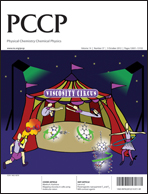Contribution of the π electron to the N–H⋯O![[double bond, length as m-dash]](https://www.rsc.org/images/entities/char_e001.gif) C hydrogen bond: IR spectroscopic studies of the jet-cooled pyrrole–acetone binary clusters
C hydrogen bond: IR spectroscopic studies of the jet-cooled pyrrole–acetone binary clusters
Abstract
To investigate the π bonding electron contribution to N–H⋯O![[double bond, length as m-dash]](https://www.rsc.org/images/entities/char_e001.gif) C hydrogen-bond (H-bond) formation, we applied
C hydrogen-bond (H-bond) formation, we applied ![[double bond, length as m-dash]](https://www.rsc.org/images/entities/char_e001.gif) C H-bonded structure with Cs symmetry, while the Py1–Ac2 cluster has a cyclic structure formed by a single N–H⋯O
C H-bonded structure with Cs symmetry, while the Py1–Ac2 cluster has a cyclic structure formed by a single N–H⋯O![[double bond, length as m-dash]](https://www.rsc.org/images/entities/char_e001.gif) C H-bond, dipole–dipole interactions, and weak CH H-bonds. A natural bond orbital (NBO) analysis was performed to reveal the H-bond strength in Py–Ac binary clusters. For the Py1–Ac2 cluster, we found that the donor–acceptor interactions are not only the n → σ* type (O atom lone pair to the NH anti-bonding orbitals), but also the π → σ* type (the CO π bonding to the NH anti-bonding orbitals). By analyzing the relationship between the frequency shift and the stabilization energy in donor–acceptor interactions, we concluded that larger red-shift of the NH stretching vibration in the Py1–Ac2 can be explained by not only the lone pair and the π electron contributions to the N–H⋯O
C H-bond, dipole–dipole interactions, and weak CH H-bonds. A natural bond orbital (NBO) analysis was performed to reveal the H-bond strength in Py–Ac binary clusters. For the Py1–Ac2 cluster, we found that the donor–acceptor interactions are not only the n → σ* type (O atom lone pair to the NH anti-bonding orbitals), but also the π → σ* type (the CO π bonding to the NH anti-bonding orbitals). By analyzing the relationship between the frequency shift and the stabilization energy in donor–acceptor interactions, we concluded that larger red-shift of the NH stretching vibration in the Py1–Ac2 can be explained by not only the lone pair and the π electron contributions to the N–H⋯O![[double bond, length as m-dash]](https://www.rsc.org/images/entities/char_e001.gif) C H-bond, but also the dipole-interaction between Py and non-H-bonded Ac. We also discussed the structures of Py2–Ac1 clusters.
C H-bond, but also the dipole-interaction between Py and non-H-bonded Ac. We also discussed the structures of Py2–Ac1 clusters.
![Graphical abstract: Contribution of the π electron to the N–H⋯O [[double bond, length as m-dash]] C hydrogen bond: IR spectroscopic studies of the jet-cooled pyrrole–acetone binary clusters](/en/Image/Get?imageInfo.ImageType=GA&imageInfo.ImageIdentifier.ManuscriptID=C2CP41564J&imageInfo.ImageIdentifier.Year=2012)

 Please wait while we load your content...
Please wait while we load your content...
![[double bond, length as m-dash]](https://www.rsc.org/images/entities/h2_char_e001.gif) C hydrogen bond:
C hydrogen bond: